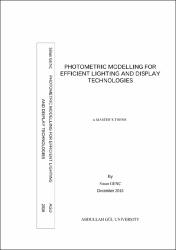| dc.contributor.author | GENÇ, SİNAN | |
| dc.date.accessioned | 2020-07-21T08:15:55Z | |
| dc.date.available | 2020-07-21T08:15:55Z | |
| dc.date.issued | 2016 | en_US |
| dc.identifier.other | Tez No: 450493 | |
| dc.identifier.uri | https://hdl.handle.net/20.500.12573/304 | |
| dc.description.abstract | Using light emitting diodes (LEDs) as lighting devices has come to the sight as a compulsory step in terms of the energy efficiency. Almost a quarter of total consumed energy that generated whole around the world is used for lighting. Using incandescent bulbs as lighting devices is forbidden in most of Europe and light emitting devices are one of the most important choices in order to compensate that need. Their high performance in terms of both luminance levels and energy efficiency has opened a new research area to increase their performance. White light has different requirements based on an application area. Providing that necessities by engineering on light parameters is one of the main aims of this thesis. In display technology, the development from cathode ray tubes to organic light emitting devices has increased the performance of both display quality and energy efficiency. Enhancement of the color scale that can be perceived by the human eye is the main purpose so that the reference color area increases systematically. The last announced reference, Rec.2020, has two thirds of the colors perceived by human eye. In this thesis, considering the current references such as National Television System Committee (NTSC) color gamut, the broadening of Rec.2020 is also presented as a new important figure of merit. In this thesis, we have studied on the investigation of the parameters of the emitters, i.e., peak emission wavelength, full width at half maximum and peak intensity to achieve the desired quality white light. Although it is possible to get white light in each step, the high quality requirements have been implemented by four colors within the simulation vi range of thesis which possess color rendering index value >90, correlated color temperature <4000K and luminous efficacy of optical radiation 380 lm/Wopt. In addition, in terms of display technology, we have shown that using ultra narrow emitters is an optimal choice for achieving Rec.2020 color triangle. Using ultra-narrow emitters, it is possible to obtain 99,89% of the Rec.2020 that also almost covers the NTSC. As expected, using a fourth color component cyan has increased the reached area to 169,55% of NTSC on color space dramatically | en_US |
| dc.language.iso | eng | en_US |
| dc.publisher | Abdullah Gül Üniversitesi | en_US |
| dc.rights | info:eu-repo/semantics/openAccess | en_US |
| dc.subject | Colorimetry | en_US |
| dc.subject | color gamut | en_US |
| dc.subject | display technolog | en_US |
| dc.subject | lighting | en_US |
| dc.subject | high quality white light | en_US |
| dc.title | Photometric modelling for efficient lighting and display technologies | en_US |
| dc.title.alternative | Verimli aydınlatma ve ekran teknolojileri için fotometrik modellemelerin gerçekleştirilmesi | en_US |
| dc.type | masterThesis | en_US |
| dc.contributor.department | AGÜ, Fen Bilimleri Enstitüsü, Elektrik ve Bilgisayar Mühendisliği Ana Bilim Dalı | en_US |
| dc.contributor.institutionauthor | GENÇ, SİNAN | |
| dc.relation.publicationcategory | Tez | en_US |


















